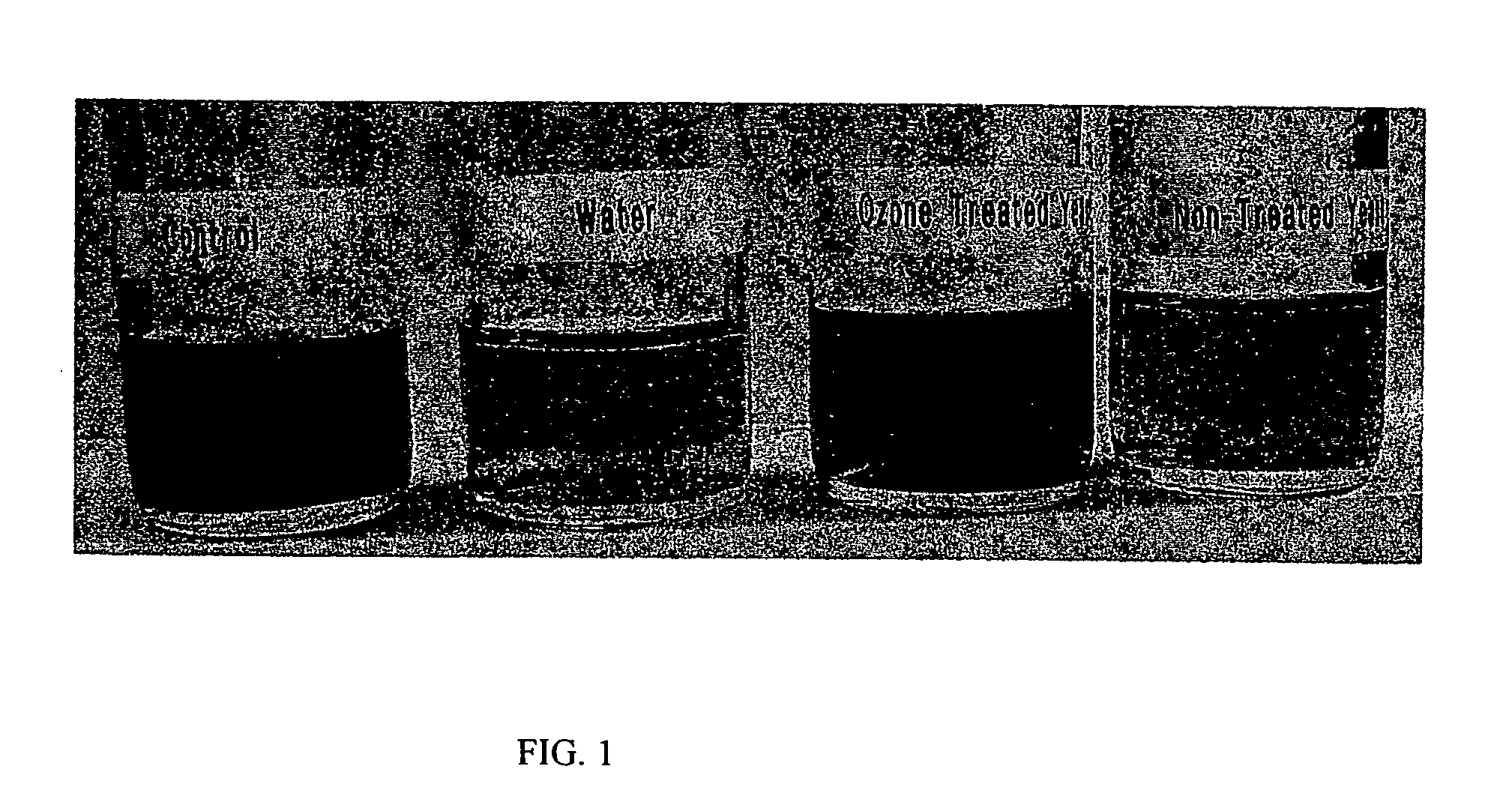Personal care composition containing ozone-stressed yeast lysates
a technology of ozone-stressed yeast and composition, which is applied in the field of compositions containing ozone-stressed yeast lysates, can solve the problems of increased trans-epidermal water loss, drying and cracking of the skin, and ozone can affect lipids, proteins, nucleic acids and sugars,
- Summary
- Abstract
- Description
- Claims
- Application Information
AI Technical Summary
Benefits of technology
Problems solved by technology
Method used
Image
Examples
example 1
Example of Yeast Lysate from Grown Saccharomyces
Organism and Media
[0037]The organism used in this study was S. cerevisiae (Red Star baker's yeast). Stock culture was maintained on a yeast peptide dextrose (YPD) agar slant (Difco). The working culture was maintained in YPD broth at 4° C. The fermentation was carried out with the medium containing 10 270 g / L yeast extract, 8 g / L NH4SO4, 3 g / L KH2PO4, 2 g / L MgSO4, and 0.5 mL / L Antifoam A. Unless otherwise stated, the working volume for fermentation was 2 liters (L).
[0038]A New Brunswick Bioflo 110 benchtop bioreactor (Edison, N.J.) equipped with automatic 275 pH, temperature, agitation, dissolved oxygen (DO) and antifoam controls was used. The 2-L vessel was equipped with air in- and out-ports, alkali and medium addition ports, and effluent side ports. Medium pH was maintained at 5.5 by adding 4 M NaOH and / or 4 M H2SO4. Aeration was maintained at 1 vvm (volume of air / working volume of fermentor / min) and DO level was kept at ...
example 2
Yeast Gene Microarray Analysis: Comparing Effects of Ozone Verses Hydrogen Peroxide on Gene Expression
[0048]To determine whether ozone caused yeast to respond differently than it responds to hydrogen peroxide, yeast was exposed to either ozone or hydrogen peroxide for the same length of time. The yeast was then subjected to microarray analysis to determine what genes were up-regulated and which were down-regulated as a result of the treatments. The following test protocols were employed in this study.
Yeast Cell Culture and Treatment
[0049]Cell cultures of S. cerevisiae were grown as described in more detail above. At the desired time after treatment, a 3-6 ml aliquot of the yeast culture was obtained and the cell density was measured spectrophotometrically at 600 nm. Culture samples having an Optical Density (OD) between 1 and 2 and were diluted with culture media as necessary to bring them within this range and the final volume of the aliquot was recorded. The aliquot was then centr...
example 3
In Vitro Protective Effect of Ozone-Stressed Yeast Lysate on Carmine Dye Oxidation
[0073]In-vitro studies were performed by the degradation of potassium indigotrisulfonic acid upon exposure to ozone (Wentworth Jr. et al. 2003). Samples of ozone-stressed (or ozone treated) yeast lysate, non-ozone-stressed treated yeast lysate, and distilled water were compared. Approximately 36 mL of indigo reagent was mixed with 100 mL of sample to give an absorbance of 0.5. The final concentrations of yeast lysate samples were around 2%. Samples were then purged with 1.5 L / min of ozone / air stream containing 10 mg / L of ozone for 10 minutes. Absorbance values for samples were measured at 600 nm at different time intervals. Ozone has the unique ability to cleave the double bond in indigo to give the colorless isatin sulfonic acid compound, see below.
[0074]Results from ozone exposure of water, non-ozone-stressed yeast lysate and ozone treated yeast lysate are shown in the photograph in FIG. 1. The ozone...
PUM
| Property | Measurement | Unit |
|---|---|---|
| temperature | aaaaa | aaaaa |
| temperature | aaaaa | aaaaa |
| concentration | aaaaa | aaaaa |
Abstract
Description
Claims
Application Information
 Login to View More
Login to View More - R&D
- Intellectual Property
- Life Sciences
- Materials
- Tech Scout
- Unparalleled Data Quality
- Higher Quality Content
- 60% Fewer Hallucinations
Browse by: Latest US Patents, China's latest patents, Technical Efficacy Thesaurus, Application Domain, Technology Topic, Popular Technical Reports.
© 2025 PatSnap. All rights reserved.Legal|Privacy policy|Modern Slavery Act Transparency Statement|Sitemap|About US| Contact US: help@patsnap.com


